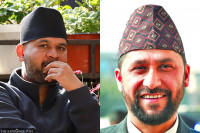Politics
Experts blame centralised governance for instability in the provinces
Some fear growing aberrations could fuel public frustrations against federalism.
Tika R Pradhan
When CPN-UML chair KP Sharma Oli became prime minister on February 15, 2018, there was a sense of stability in the country because the left alliance of the UML and the Communist Party of Nepal (Maoist Centre) had a comfortable majority.
The two parties united to form the Nepal Communist Party (NCP) in May 2018. The party governed six of the seven provinces. The governments in Province 1, Bagmati, Gandaki and Lumbini were led by the party’s UML faction while the Maoist faction formed governments in Karnali and Sudur Paschim.
But three and a half years later, four of Oli’s close leaders were stripped of their positions as chief ministers. Sherdhan Rai of Province 1 and Dormani Poudel of Bagmati were replaced by former leaders close to Madhav Nepal—Bhim Acharya and Asta Laxmi Shakya—so as to retain them in the UML.
In Province 2, following the split in the UML and the Janata Samajbadi Party, Chief Minister Lalbabu Raut reshuffled his Cabinet to induct leaders from the Maoist Centre and the CPN (Unified Socialist), throwing out ministers from the newly formed Loktantrik Samajbadi Party of Mahantha Thakur.
After the Supreme Court’s March 7 decision not to authenticate Nepal Communist Party (NCP), the UML and the CPN (Maoist Centre) were revived in their pre-unification forms. Later, the conflict between the Oli and Nepal factions in the UML led to the party’s split. Nepal launched his own party, the CPN (Unified Socialist), on August 25.
When the party was on the verge of splitting, Oli made a quick move and changed the remaining two chief ministers of Province 1 and Bagmati with the leaders close to Nepal.
Shakya replaced Poudel on August 18 while Acharya replaced Rai on August 26—a day after the CPN-UML split. People were wondering why Acharya decided to become the chief minister just for weeks as he was well aware that he would not be holding the post for more than a month, with many provincial assembly members supporting Nepal.
Observers and political analysts say the two major splits— first in the NCP and then in the UML— have left the provincial governments unstable.
“After the split in the Nepal Communist Party (NCP), all tiers of the government are in a mess and the provinces cannot remain aloof,” said Khim Lal Devkota, an expert on federal affairs who is also a member of the National Assembly. “After the federal government, the repercussions of the parties' splits are now seen across the provinces.”
Devkota said the mess in provincial governments would help people like Mahesh Basnet, a UML leader who has been demanding that the provincial governments should be scrapped. “It’s all because of the inefficiency of KP Sharma Oli, whose failure to keep the party united and his misadventures have led the whole country to a mess.”
Being the first governments after the elections were held as per the new constitution, the provincial and federal governments should have focused on developing the foundations of the federal set-up and strengthening organisational structures but the provincial governments are weakening them instead.
To appease the coalition partners, Lumbini Chief Minister Kul Prasad KC on Sunday formed the largest provincial Cabinet with 17 ministers by inducting 10 more ministers. According to leaders, the Maoist Centre and the Nepali Congress have agreed to share the chief ministerial position for nine months each.
“Provincial governments are focusing on appointments and benefits instead of strengthening the federal structures,” said Devkota. “The Lumbini chief minister forming a Cabinet of 17 ministers and the Province 1 chief minister making appointments even after knowing he will be unseated within weeks show how our leaders are weakening federalism.”
The 110-member Bagmati provincial assembly currently has 109 members following the death of UML member Pashupati Chaulagain. Now the UML has 43 members, Maoist Centre 23, Nepali Congress 22, CPN (Unified Socialist) 13, Bibeksheel Sajha 3, Nepal Majdoor Kisan Party 2, Rastriya Prajatantra Party 2 and one independent member. The figure shows that Shakya is in a clear minority and she is sure to lose the confidence vote on October 21.
Mrigendra Bahadur Karki, executive director at the Centre for Nepal and Asian Studies, said the changes in governments have not only given rise to instability but have also promoted vested interests of various political groups.
“The political system we adopted was the best but the leaders and political parties have yet to grasp its essence,” said Karki. “The ongoing mess in provincial governments could fuel public frustration but I don’t think that would reach the level of a revolt.”
Political analyst Rajendra Maharjan said the split in the Nepal Communist Party (NCP)—now into three parties—has adversely affected the provincial governments.
“The mess in the provinces indicates that the country, despite switching to a federal system, has yet to get rid of the centralised mindset and there is no autonomy for the provinces,” said Maharjan. “Any small change in the parties directly affects the governments in the provinces and even at the local level.”
Maharjan said the splits in the CPN-UML and the Janata Samajbadi Party have created unease in the provincial capitals and in many local governments. “We have a federalism system controlled by the centre,” said Maharjan. “So we are bearing the brunt.”




 8.12°C Kathmandu
8.12°C Kathmandu


.jpg&w=200&height=120)












